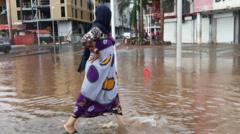Heavy rains from Storm Dikeledi led to the issuance of a highest state of alert in Mayotte, following the catastrophic effects of Cyclone Chido just a month prior. The new storm has caused flooding and mudslides across the archipelago, affecting the safety and security of residents in the area.
Authorities reported that as Storm Dikeledi brought violent winds and heavy rains to Mayotte, initial flooding began to manifest, with the prefect of Mayotte, François-Xavier Bieuville, voicing concerns about the severity of the weather. He warned that significant mudslides had begun to form, and officials recommend that residents take precautions to safeguard themselves against potential hazards.
The southern village of Mbouini, previously unscathed by the devastation of Cyclone Chido, is now under water. With heavy rainfall forecast to persist even after the storm passes, local officials have maintained a red alert status while at least 14,500 residents have been relocated to emergency shelters for safety.
As of Sunday, the storm, which made landfall in Madagascar, has reportedly led to at least three fatalities in the neighboring country. Meanwhile, forecasters predict that the storm will both intensify over the next 24 hours and closely approach the coast of Mozambique, where authorities are monitoring degraded weather conditions as the region recovers from Cyclone Chido, which claimed the lives of 120 individuals.
Historically, Mayotte is known for its volatile weather patterns and socio-economic challenges. With approximately 320,000 residents, many of whom dwell in shanty towns, the region faces unique difficulties when it comes to disaster response and recovery efforts.
The devastation wrought by Cyclone Chido in December, which registered as the worst storm in nearly a century, left communities struggling as initial death toll figures reached into the hundreds before being revised down. As the territory grapples with repeated storms, the resilience of Mayotte's residents continues to be tested.
Authorities reported that as Storm Dikeledi brought violent winds and heavy rains to Mayotte, initial flooding began to manifest, with the prefect of Mayotte, François-Xavier Bieuville, voicing concerns about the severity of the weather. He warned that significant mudslides had begun to form, and officials recommend that residents take precautions to safeguard themselves against potential hazards.
The southern village of Mbouini, previously unscathed by the devastation of Cyclone Chido, is now under water. With heavy rainfall forecast to persist even after the storm passes, local officials have maintained a red alert status while at least 14,500 residents have been relocated to emergency shelters for safety.
As of Sunday, the storm, which made landfall in Madagascar, has reportedly led to at least three fatalities in the neighboring country. Meanwhile, forecasters predict that the storm will both intensify over the next 24 hours and closely approach the coast of Mozambique, where authorities are monitoring degraded weather conditions as the region recovers from Cyclone Chido, which claimed the lives of 120 individuals.
Historically, Mayotte is known for its volatile weather patterns and socio-economic challenges. With approximately 320,000 residents, many of whom dwell in shanty towns, the region faces unique difficulties when it comes to disaster response and recovery efforts.
The devastation wrought by Cyclone Chido in December, which registered as the worst storm in nearly a century, left communities struggling as initial death toll figures reached into the hundreds before being revised down. As the territory grapples with repeated storms, the resilience of Mayotte's residents continues to be tested.




















